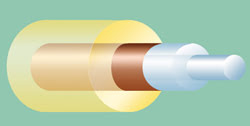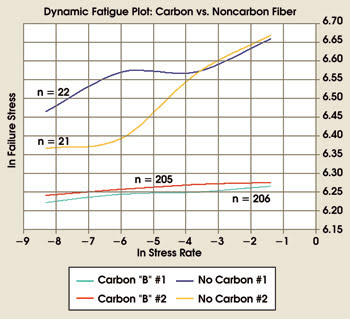Cathy Ciardiello, OFS Specialty Photonics Div.
Fiber optics technology has found use in a variety of sensing applications in the oil and gas industry. Distributed temperature, pressure, vibration, strain and flow are a few of the parameters that such sensors measure, with the result being real-time monitoring of oil wells and pipelines.
The technology differs from the standard fibers developed for telecommunication applications. They perform well optically in geophysical devices, but their acrylate coatings limit them to temperatures lower than 85 °C. Geophysical environments, however, present harsh conditions: temperatures up to 300 °C, high pressure, steam, destructive chemicals and abrasive deployment. In addition, as temperatures rise, attenuation caused by hydrogen ingression increases. Such conditions demand unique coatings and fiber designs.
Coatings are applied to optical fibers because microscopic flaws in the surface of the glass grow over time as they are exposed to water vapor and mechanical stress. Fiber fatigue can be characterized by a measurable fatigue resistance factor, or “n value,” of the fiber.
This dimensionless parameter is around 20 for fibers coated with acrylate, silicone or polyimide. Apply carbon as an underlying coating, and the n value increases to greater than 100. The very thin (0.03 to 0.04 μm) layer of carbon chemically bonds with the glass surface during fiber draw, forming a hermetic seal along the length of the fiber. Carbon is very thin, so a polymer coating is required to provide mechanical protection. Both silicone and polyimide are good candidates.
Taking the heat
Because both glass and carbon can withstand temperatures beyond 300 °C, the rating of the polymer coating material determines the operating temperature of the fiber. There are three identifiable temperature categories based on commercially available coatings. Acrylate-coated fibers are temperature-rated to 85 °C maximum, but they can survive temperatures somewhat higher if deployed inside the gel-filled metal tubing commonly used inside wells.
Silicone coatings can withstand up to 200 °C and are more resistant to chemicals and water vapor. Nevertheless, the lower modulus of silicone requires the application of a harder outer buffer, such as PFA.
Polyimide coatings can withstand up to and sometimes more than 300 °C, and they are resistant to abrasion and chemicals. They are ultrathin, at only 15 μm, and do not need to be buffered.
As a result, both the carbon/silicone/PFA and the carbon/polyimide coating systems provide an excellent hermetic seal and temperature protection from 100 to 200 °C and 200 to 300 °C, respectively.

Figure 1. The typical construction of a geophysical fiber includes a silica core and cladding followed by a hermetic carbon layer and a polyimide.
One issue of particular concern in geophysical applications is hydrogen ingression, which is the absorption of H2 molecules into the fiber core. The source of this free hydrogen can be metal corrosion or outgassing of polymers or water in the down-hole environment. As the temperature rises, hydrogen evolution and diffusion rates increase, causing a rise in attenuation that leads to failure of the sensor.
The lifetime of deployed sensors thus can vary from years to only weeks before significant darkening occurs. There are essentially three ways to approach this problem: Create barriers that absorb hydrogen before it reaches the core; design the glass to be less reactive to hydrogen; or choose materials that have a low tendency for hydrogen evolution.
The hermetic carbon coating can effectively block hydrogen ingression at temperatures up to 120 to 130 °C. At higher temperatures, the use of stainless steel tubing and additional layers of steel cable can slow ingression. Also useful are getters, materials that scavenge hydrogen. These materials are used in many industries, and different ways of incorporating them into the tubing construction, the fill gels and even the fiber cladding construction are being investigated.

Figure 2. Dynamic fatigue is measured using tensile stress on the fiber to failure.
The cores of most optical fibers are doped with germanium. Redesigning the fiber with a pure silica core or modifying the dopants used can minimize the impact of the ingression and increase fiber lifetime. In addition, if its sources down-hole are identified, hydrogen can be minimized by carefully choosing materials with a low tendency to outgas.
Fiber optic sensors provide valuable data to the oil industry that translates to more efficient production and increased profits. Sensor demand will continue to grow as specialty fiber manufacturers make incremental improvements to fiber designs and coatings designed to boost sensor lifetime further in these harsh environments.
Meet the author
Cathy Ciardiello is marketing manager of geophysical and sensor products for the OFS Specialty Photonics Div. in Avon, Conn.; e-mail: [email protected].